#it’s like. directly asserting that he’s an animal and she’s the one who sics him on people
Explore tagged Tumblr posts
Text
i knew mizora was big on the whole treating wyll like a dog thing and i already fucking despised it, but nothing could’ve prepared me for hearing her call herself his “handler”. being a bitch to her isn’t enough anymore i need to destroy her and i need to do it now. wyll baby i’m so sorry she talked to you like that i love you so much.
#mizora when i catch you mizora#ive seen that scene so many times now but its never hit me as hard as it did that time#something about that comment just. made my blood boil even more than usual#like i feel like it takes the dehumanization to another level. it’s not just calling him pup or an offhand comment about a leash#it’s like. directly asserting that he’s an animal and she’s the one who sics him on people#and i feel like she says it seriously. like she means that#like calling her his patron is offensive because that would imply more agency and humanity in him than she thinks he has#which. makes me watch to throw up. to be quite honest#brb smashing my computer screen in a futile attempt to maim and murder and destroy her#wyll ravengard#mizora bg3#bg3#baldur’s gate 3
16 notes
·
View notes
Text
Is it for Me?
The Whitaker Era
An Unearthly Child to The Dalek Invasion of Earth
I’m dividing up eras by changes in the head creative staff. Any time a new doctor, head writer, producer, or showrunner comes in the show changes it’s direction. This particular era is named after the shows first head writer, David Whitaker. Other creative heads during this time would be Sydney Newman and Verity Lambert as the creators and producers of the series.
Where to Start
As the very first season of the show ever created, this era is a very good one to start with for newcomers. Even if you decide not to watch the entire era, I would still recommend everyone to watch the very first episode An Unearthly Child at some point. It explains the basic premise of the show and establishes core concepts that will last for over 50 years.
If you do decide to watch the whole era be sure to watch in order though, as stories directly lead into one another, there are clear character arcs, and continuity building.
Also a word to the wise, take it slow. 60s Doctor Who is a very different beast to modern day Who in terms of pacing. Rather than having one or two 47 min episodes, the show has 25 min episodes or “parts” that come together to create a whole story or “serial”. And serials can regularly have 6 or more parts to them. Basically don’t try to watch all of The Daleks in one sitting is all I’m saying.
Missing Episodes
So for those of you new to Who, back in the 70s before VHS and DVD a lot of the episodes from the 60s were wiped or burned out right. We’ve recovered or restored the majority of these episodes, and the search for the missing ones continue to this day, but until then, if you wish to “watch” these stories you’ll have to either listen to the audio recording, watch the reconstructions, or read the novelizations. There’s also a select few that have been animated.
As for the Whitaker era there are two serials with missing episodes.
Marco Polo - All seven parts are completely missing. Not even clips survive. Which is a shame because it’s an often highly regarded story. The audio however does survive and there are at least three different recons to choose from. My personal favorite is the color recon from Loose Cannon
The Reign of Terror - only two parts are missing and good news, they’re ones that have been animated so you can watch the story in full.
Tone
The first era is a very serious show. All involved in the production were committed to making sure the show “felt real”. All of the present danger is presented with the gravest sincerity by the cast and crew no matter how outlandish the concept or poor the effect. And the show doesn’t shy away from darker subject matter or bleak moments.
That’s not to say that the series is overly grim and gritty either, but if you’re looking for something on the more humorous side this might not be the era for you.
Oh there are of course plenty of the cheesy sci-fi stuff we’ve come to associate with Who, like Daleks, talking brains in jars, and giant bugs ect. But there’s also morally ambiguous antagonists and protagonists, exploration of the dark side humanity, the effects of paranoia, discussions of imperialism and fascism, and quite often there’s no right or wrong answer given to complex moral issues. Even Ian’s persuasion to the pacifist Thals to get the them to fight their oppressors in The Daleks is a debate that still holds relevance today.
Basically this a show that challenges you. If you’re willing to look past the cheap effects, slow pace, and well worn fantasy/sic-fi tropes, then you’ll be rewarded with an experience that treats the viewer intelligently.
Also as an added bonus to those of you that are romantically inclined and love shipping. This era features what is generally considered by the majority of fandom as the best romance ever written for the series.
The Doctor
The first Doctor, at least in his first season, is a very different Doctor from what we’re use to today. He’s not the hero, not yet. He starts off as a morally ambiguous, mysterious alien who slowly grows more heroic as his adventures influence him to become more proactive.
This is a deliberate character arc. One that follows him thought out his tenure. But never is it more pronounced than in this era. Going as far to kidnap and threaten others just to save his own skin in the first serial. Even as he softens up and becomes more likable his primary motivation in each episode is often survival. He just so happens to help others along the way rather then intentionally setting out to save people.
If you really enjoy long term character development, nothing is better than watching the Doctor evolve into a hero. However if your tastes lends towards the more open and friendly Doctors, One might come as a shock to your system.
The Companions
Barbara - Barbara starts off as a woman completely out of her depth. She is thrust into an adventure she doesn’t want to be on. Stolen from her home and forced to face monsters, she is utterly terrified! Longing for safety and her old life, she clings to her colleague Ian. The only recognizable thing in her now strange surroundings.
Or at least she starts off that way. Over time Barbara grows into a strong, competent, intelligent, compassionate character who becomes a hero in her own right. In truth, Barbara winds up saving the day more often then the Doctor himself. She is his true equal; not in terms of abilities but in terms of story importance. She’s one of the few companions to be given just as much focus as him.
Which is the only complaint I’ve ever heard given to Barbara as a character. I can’t stress enough how rare it is to find someone who genuine dislikes her. Most either adore her, or thinks she’s merely “ok”. But a very few have complained that she upstages the main hero, and is a duller character when compared to the Doctor and his more long term development and mysterious backstory. One person claimed, and I quote, “Watching her is like watching your Mom running around in space”.
Well I don’t know about any of ya’ll, but my mom is awesome and I totally would love seeing her save the day on tv.
Ian - Unfortunately, Ian doesn’t get as much character development as the rest of his teammates. Like Barbara, he’s an unwilling traveler who longs for home but over time grows more accustom to adventuring. Unlike Barbara, there is no point where he learns to become a hero, he just is a hero from the get go.
In fact in any other show Ian would be the main hero. He’s brave, resourceful, smart, caring, and can defeat anyone with just his bare hands. Dude even wrestled a Dalek once.

But this isn’t any other show, it’s Doctor Who, and Ian is an equal member of the tardis team. Meaning he helps to save the day the just as much as Babs or the Doctor, but never upstages them or becomes the de facto leader.
But the guy is more than just the muscle of the group. If Barbara is “Space Mom” than Ian would be “Space Dad.” He is deeply concerned about the well being of others both emotionally and physically, and he’s often the mediator when comes to internal conflicts within the group. While also being an over protective papa bear if you threaten anybody he knows. And heaven help you if you try to separate him from Barbara.
(To my Sonic followers who might be reading this, “Barbara and Ian” are the “Bunnie and Antoine” of Doctor Who.)
Susan - Susan is a much more decisive character than either Ian or Barbara. Either you love her or you find her annoying. There’s rarely any in between, I’ve found.
Ignoring her unique place within the series as the Doctor’s granddaughter, and the controversy that it spawns to this day. Susan can be equally frustrating and/or fascinating for a number a reasons.
For starters, when people hear that Susan is meant to be a timelady a lot of people just assume she’s going to be a female Doctor counterpart in the same vain as Romana or River. They’ll then express disappointment when turns out Susan isn’t an ass-kicking genius who takes the Doctor down a peg or two. Even her actress, Carole Ann Ford, originally left the role because she felt the character wasn’t as assertive as she was lead to believe she would be.
Instead what you get with Susan, is infinitely more complex. IMHO. Susan’s development within the show is a coming of age story as seen through the eyes of an alien being. Like most good sic-fi/fantasy it takes a concept that is relatable on a emotional level and then explores it through the fantastical.
She’s a weird alien outcast, who has psychic powers and dances funny, but you still understand where she’s coming from when she grows increasingly frustrated with her Grandfather’s way of life and wants to regain the home she lost, and yet is afraid to cut ties with the only family she has left. Even if you can’t imagine what living in a time machine would be like, you can still probably remember what it was like to argue with your parents about how you wanted live your life while uncertain of what your future would be.
So Susan’s not a “strong independent woman!” character type, but she is by no means useless. Susan doesn’t just have psychic powers, she a psychic prodigy! Her powers surpasses not only that of the Doctor but most other timelords as well. She can read minds, sense danger, and even on rare occasions have premonitions.
This ability however ties into Susan’s greatest character flaw. One that is often a deal breaker to some people. Susan is paranoid. Granted it’s often with good reason. If Susan says something bad is going to happen, 9 times out of 10 it’s going to happen. Unfortunately, like Cassandra of Troy few people take her seriously, including the rest of the Tardis team even when they know she’s psychic!
She’s also quite clingy at times. While her past is shrouded in mystery, the same as the Doctor’s, there’s a enough hints on screen to tell us that Susan can never return to Gallifrey. She is forever separated from everyone she’s known and loved save her for grandfather and eventually Babs and Ian, who she unofficially adopts as family. Combine her paranoia and fear of lost together and you have someone who has trouble letting go.
At the end of the day, Susan has a lot more hidden depth then at first glance, but it requires you to take the time to really watch all of her story. And if you happen find her character flaws more annoying than interesting, than you’ll might not want to invest that much time with her.
Personal Opinions
This is my all time favorite era of the show, with my all time favorite tardis team. And yes, Susan is my favorite companion in the series. An Unearthly Child, Marco Polo, and The Dalek Invasion of Earth are all in my top ten stories. And even then I can’t think of single story that I wouldn’t rate lower than a 4 out 5. I would highly recommend it, but still I tried to be as unbiased as possible when giving this review.
#Doctor who#classic who#the doctor#the first doctor#william hartnell#susan foreman#Barbara Wright#ian chesterton
14 notes
·
View notes
Text
Wing Meta: Kalas
Now that the holidays (and extended family interactions =____=) are over, let’s talk about our favorite fuckup! :D
I think this one has even more spoilers than the Xelha post.
Wing Meta: Xelha
Wing Meta: Savyna and Lyude
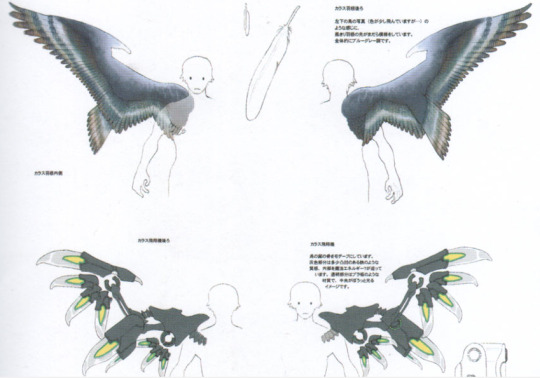
So, good ol’ カラス. There’s little point in speculating about the inspiration for his wings (since the game is very, very clear on the raven theme), buuuut I’m gonna do it anyway ‘cause that’s just the kinda guy I am.
Well, that and the fact that they’re no ordinary corvid wings. They’ve got a distinctive hook off the wrist, which is most likely an unusually pronounced alula (aka bird thumb), meaning that what we’re looking at is exposed bone. Spooky! (Also appropriate, given the whole carrion bird/harbinger of apocalypse thing.)

Fun fact! According to Wikipedia, “alula” translates to “winglet”! And it’s also called a “bastard wing”. And Kalas has no parents, so....
Anyway, his wing is otherwise a fairly standard shape for that family... except for the pronounced secondaries. Alas, I’m not actually a bird person so I won’t speculate further about that (so as to spare myself any more hours of futile corvid research. The winglet diagram comes in real handy here, since it’s basically a mirrored skeleton of his other wing). Finally, he’s got falcon-like stripes on his pinions resulting in a mix of browns and greys.
Even expanding into other corvid species, I could’t find any that truly matched these details.

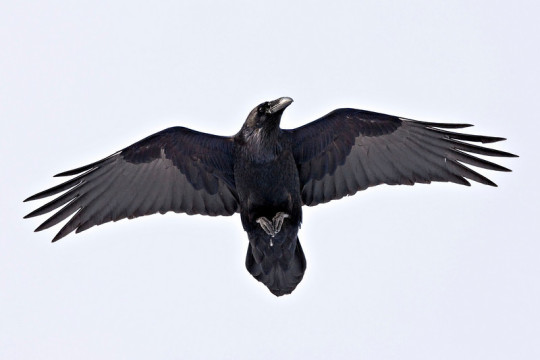
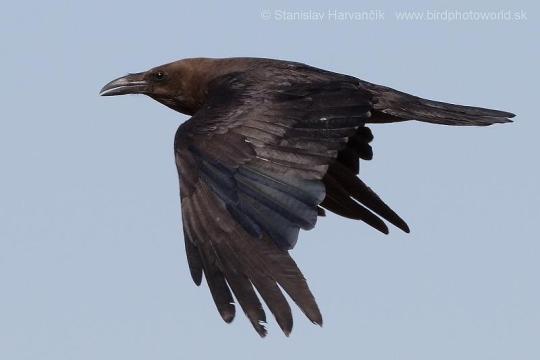
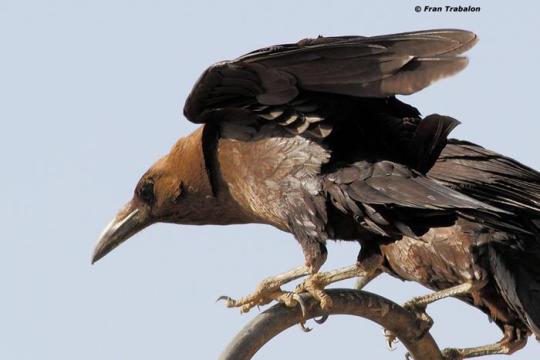
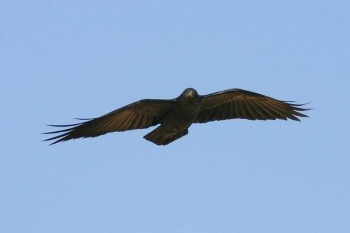

In any case, onto symbolism!
Ravens are consistently depicted across cultures as tricksters and omens of misfortune and death, though the latter is isn’t nearly as universal.
Trickster Ravens
Corvids in general are considered highly intelligent birds, an attribute that they mainly use for theft. For example, they’ve been known to yank the tails of other birds/animals in order to distract them from a tasty, tasty meal. Magpies in particular have such a rep for stealing End Magnus shinies that they’ve become synonymous with the act in much the same way as we use “packrat” to describe a hoarder and “chicken” a coward.
Ravens As Omens
In Greek tradition, a white raven was Apollo’s messenger. Ravens are more relevant in terms of the practice of augury, a form of divination in which certain birds are observed for signs of favor/displeasure of the gods. Ravens (and crows) fall under the label of “oscines”, or birds whose omens are determined based upon their calls. They aren’t regarded as being inherently unlucky (that dubious honor goes to the owl).
According to Wikipedia (citation desperately longed for), in Serbian folklore ravens “appear in pairs and play the role of harbingers of tragic news... in combination with female characters as receivers of the news”.
Unlike black cats, there’s an emphasis on ravens as a sign of misfortune to come rather than an embodiment of it. Similarly, they don’t directly symbolize death; instead they’re merely associated with it, much in the way one might associate the fall colors with the coming winter.
Ravens in Japanese Folklore
I went through many layers of questionable research to get this info, so it damn well better be accurate.
Yatagarasu, the 3-legged crow, was a guide sent by Amaterasu to Emperor Jimmu in order to guide his lost ass to his future seat of power.

Seen here: Yatagarasu and Jimmy’s lost ass (left).
After Google Fu’ing for awhile to figure out the meaning behind a sentence found word-for-word and lacking citation in nearly every article on Yatagarasu, I finally managed to track down an additional piece of lore: he is apparently an incarnation of Kamo Taketsunumi no Mikoto, god of good fortune and founder of the Kamo clan (???? Maybe??? All those articles weren’t kidding when they said the legends of Yatagarasu are contradictory).
Color Symbolism
This is, of course, something the varies from culture to culture. The relevant symbols here are black and white.
Black
West
death/void
authority
evil
mystery
Japan
evil
bad luck (take this with a grain of salt--I don’t trust my sources on this)
White
West
purity
peace
holiness
sterility
Japan
death
mourning
simplicity/purity
Interpretation
Kalas and Fate
So how does this shape how we can interpret Kalas?
It’s best to start with how he got the name in the first place.
Hearing you were not the perfect being [Geldoblame] had envisioned, he called you an ill omen, a cursed premonition of things to come. He named you Kalas, which means Raven in a long-lost language.
Larikush, on the origin of Kalas’ name
I guess it was the reason for my existence, and my hatred.... Something I just couldn’t get rid of.
Kalas, on why his name was the only thing he remembered after Alfard
And, of course, straight from Emperor Gelnochill himself:
I found you Kalas, you sickly raven!!!
Geldohead, triple exclamation his
I find Kalas’ comment the most interesting, since it’s an explicit reference to the theme of destiny yes I said it that is woven into the Baten Kaitos as a whole. One of the things I really like about this series is the interplay between fate and choice--many characters have fated roles (Kalas, Xelha, Melodia, Mizuti, Sagi, Guillo, people touched by the Dark Brethren in general) but even as they fulfill them, the narrative never treats it as if free will is antonymous with these events.
Dr. Georg’s experiments were aimed at creating a Magnus of Life. This would be the exact opposite of the End Magnus, which are symbols of death and destruction... Kalas and Malepercio may have been destined to fight one another....Kalas could be said to be a bad omen for Malpercio, a harbinger of the god’s demise
Lyude, on something that’s really sad once you’ve played Origins
Love and hatred... Melodia[sic], and Kalas... She is Malpercio’s curse to the world, Kalas must be his prayer...
Xelha, ditto
“Fate” is largely played as being somewhere between divine intervention and the consequences of choice (e.g. Malpercio seeking power from the Dark Brethren put everything in motion), hence why the Magnus of Life could and did choose not to oppose Malpercio at first. It makes for an interesting hierarchy of power, like an arch.
The Dark Brethren can be considered the keystone and Malpercio the arch itself--it is by their power that Malpercio is what it is, their locking the gods into position that keeps them from acting of their own will. Melodia and Kalas are outside forces, bound to--but unfettered by--the conflict between master and unwilling servant. Despite their role as pawns, they’re the ones with the most power. Influence can be asserted over them, but in the end it’s their hands that decide if the keystone is restored or removed.
Kalas’ identity as the ominous raven is the perfect example of this theme at play. He’s repeatedly acknowledged as an entity of misfortune, but ultimately it’s his will that decides whose. He’s no passive auspice--bad things may happen to those around him, but only by way of his own agency (and the of others. Looking at you, Geldoblameworthy-for-his-own-problems). Even at the very end, when Melodia chooses to surrender to fate, it’s he who rescues her and tells Malpercio to rest.
He and Melodia can be considered the pair of ravens, Xelha the receiver, as per her witnessing them discuss their plans in Moonguile.
Kalas the Trickster
Kalas is possibly the most wily protagonist who isn’t straight up a villain I have ever seen. Street smart, people smart, and a fantastic actor, he’s able to pull the wool over the eyes of basically anyone who isn’t already aware of what he’s trying to do. It can be surmised that he’s also gifted at sleight of hand, given that no one noticed him slip an ever-glowing magnus to the ducal heir of Mira.
The entire first half of the game is an elaborate trick on the Guardian Spirit and Malpercio, fooling them about their memories and using them as a buffer against Malpercio’s power (though one has to wonder if that wasn’t just a trick on Melodia’s part, as Kalas was already exposed to that power. It would absolutely be in character for him to nope out of the picture if he thought that coming in contact would turn him into a boob monster).
As is common in the trickster archetype, he rarely relies on brute force to achieve his goals, to the point that one of the major character shifts in the late game is him swearing to take down Malpercio. Giacomo is his other blind spot, his mere appearance sending Kalas into an otherwise unseen rage. It’s easy to overlook that these are the exceptions, given how prominent they are (and how they launch you into one of the more dreaded fights in the game).
However, when it comes down to it, most of his work is done so quietly, it becomes a major reason to replay, just to see if you can catch him. Right from the get-go, he uses Xelha’s reference to Moonguile as an excuse to head on in. When she gets mad at him for looting, he restructures his argument to appeal to emotionalism and lets her believe what she wants. And while he initially resists joining up with her, he has no problem travelling together for convenience sake (and later, presumably, to stay close to the Earth Pendant and Chaotic Trio). Then there’s his efforts to direct suspicion onto Lyude. Despite coming across as the brashest member of the party, he frequently hides behind the others in this manner.
Yatagarasu
This section won’t be as carefully constructed as the others, but I believe the allusion is intentional. For the purpose of this argument, I’m going to have Kalas’ 3 arms--his arm arms/winglets and his natural wing--stand in place of Yatagarasu’s 3 legs. (Alternatively, one could count his original wing and the white wings, but I’m not going to for reasons to be indicted.)
Xelha takes the part of Jimmu, the royal wanderer. It was, after all, her dream of Kalas that was the inciting incident for her entire part in the story, returning him to the role of omen. It lead her to send out the witches, spy on Geldoblame, and bring Kalas along even knowing his intentions. In times of uncertainty throughout the story, she turns to her desire to save him as a source of strength and guidance.
Kalas: Black and White
Melodia refers to him both as “dark-winged stranger” and “white-winged darkness”. Kalas’ treatment in the narrative is interesting regarding the idea of purity. His lack of a second wing leads to him being ostracized by everyone from Geldoblame to some Miran randos. Larikush links the single wing to Kalas being “excessively human” and Balancoir Asshole #2′s “Malformed wings are the direct result of a malformed heart. His soul must have been tainted at birth”.
Of course, once he’s touched by Malpercio, he gains a (literally) shiny new pair of wings. This is also the point where he goes from morally distraught antihero to unrepentant mwahaha’er, only changing back when he makes the choice to rip out his additional wing.
The color symbolism is a little hard to decipher here, given that it’s an Eastern game but Kalas’ design is more West-inspired than just about any other character. From a Western perspective, it’s a fairly clear-cut juxtaposition of contrary symbols--his dark wings initially foreshadow his betrayal but ultimately are associated with his good side while the white represent the acceptance he seeks but are tainted by evil.
Kalas is the fallen angel, right down to Xelha being drawn to him like a moth to flame. I could probably make a whole section on Kalas being a croc-wearing anime Lucifer but I’m kinda really uncomfy with the Church, so I’d rather save myself that stretch.
In Japan it gets more complicated, assuming that that info regarding black’s symbolism is accurate. Because while the white of death is suitable for the dark harbinger, black isn’t terribly befitting of the Divine Child. It’s possible it’s a reference to the fact that Kalas wasn’t originally the Divine Child but *shrug*
Uh, so yeah. There’s plenty more I could say but this is already too long ^^;
48 notes
·
View notes